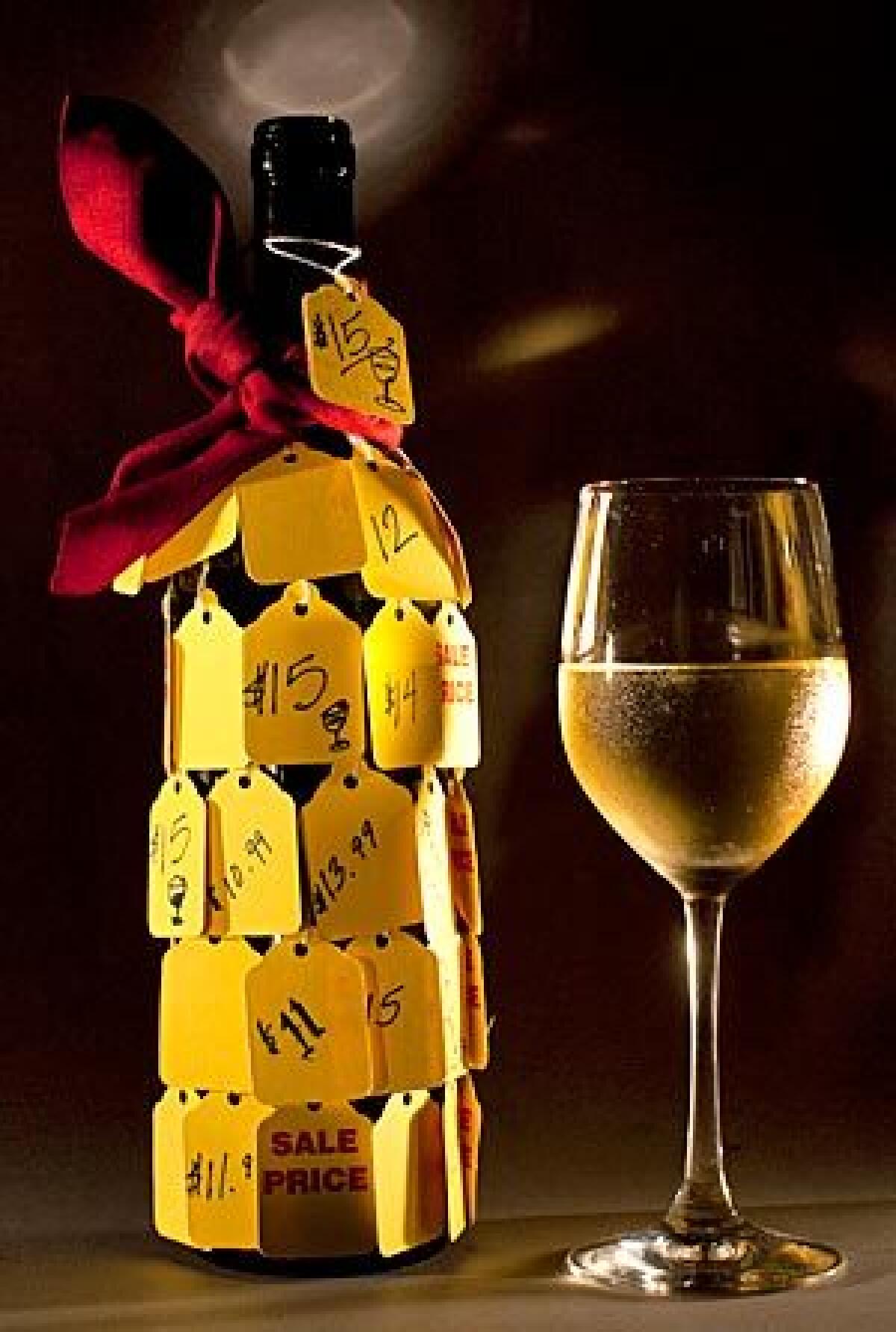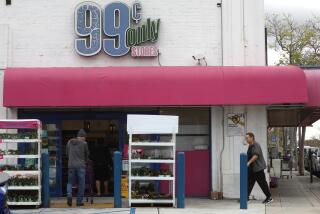$15 wine: the new normal

There are signs the American economy is improving, at least as far as wine shops are concerned. But if you think that means a return to the glory days of $150 cult Cabernets … well, not so fast.
Instead, most wine store owners, far from declaring business as back to normal, are describing a new normal, one in which the high-margin sales of wines in the $50 to $150 range are difficult — indeed, some would say they’re almost a thing of the past.
FOR THE RECORD:
Well-priced wines: In the April 14 Food section, a list of good wines for less than $15 that accompanied an article about inexpensive quality wines misspelled the name of the 2008 Aguijon de Abeja Malbec wine as Aguinon. —
To an overwhelming degree, retail customers are spending less for a bottle of wine than they did two years ago. In 2009, we wrote in these pages that, in terms of a sales sweet spot, $25 was the new $40. If anything, that median is trending further downward in 2011. For many, $15 to $20 might be the new $25.
For consumers, this is all very good news. The new focus on wines in that range has resulted in a kind of renaissance in the category, with more — and better — bottlings available than ever before. “We’ve always prided ourselves at finding great affordable wines,” says Jim Knight with the Wine House in West Los Angeles. “But now they’re more abundant, and they’re much better than they were from even a few years ago.”
Perhaps the most important trend in wine buying habits is that people are still buying the stuff. If you’re one of those who’s grown accustomed to the pleasures of the grape with your evening meal, chances are you won’t be reverting to iced tea — or even cheaply made wine — any time soon. “We’ve trained them well,” says Randy Kemner, owner of the Wine Country in Signal Hill.
So well, in fact, that Kemner says when he brought a few better-known, less-expensive “supermarket” brands into his store as an experiment, they went largely untouched. His customers had come to prefer the more curated selections in the shop, even if they had to spend a few more bucks to enjoy them.
The price category of $15 to $20 has become so important that some retailers have changed their floor plans, and their buying habits, to draw attention to it. Early last year, Simon Cocks, general manager at Larchmont Village Wine Spirits & Cheese, put in a couple of double-wide wine racks in the center aisle of his small-ish shop on Larchmont Boulevard. Every wine on those racks is $15.99 or less. It has become a huge success, reports Cocks, an island of wines in constant motion and rotation.
“It is by far the busiest section of the store,” he says. “And it really has affected my buying,” he says, “since I’m always looking for wines to fit that space.”
A great many of those wines will be from white varieties, owing in part to the fact that bottle for bottle, whites are cheaper to make: most white wines do not require expensive barrels to sit in for the better part of a year. And retailers report that their customers are no longer so enamored of reds that they eschew white wines altogether.
“People have gotten more daring with white wines” for the simple reason that they’re priced to experiment, says Kyle Meyer of the Wine Exchange in Orange. “People will take a chance on something that’s not terribly expensive.”
Meyer sells a ton of Spanish whites, Cavas, Godellos, Albariños and Ruedas, as well as Austrian Gruner Veltliners, Italian Erbaluces, Fianos and Greco di Tufos, Sauvignon Blanc from Chile and Torrontés from Argentina — all for $10 to $15. And a handful of reliable continental whites now come in liter bottlings — that’s an extra third of a bottle. He sells cases of a white blend called “Jarenincan” from Slovenian producer Crnko. Exotic, irresistibly lemony and bright, it comes in at about $13.
Interest in well-priced Spanish red wines — from Toro, Navarra, Calatayud, Tarragona and elsewhere — has been heating up for half a decade. But recent critical attention has affirmed what local retailers have been saying all along: that these wines wildly over-perform for their price. It is not uncommon to see point scores in the low-90s conferred upon wines that cost $10, $12 or $15.
“If you’re feeling uncomfortable about your expendable income,” says Wine House’s Knight, “getting a 91-point wine for $9.99 feels like a wise choice.”
The other hot Iberian category is Portugal, where producers of fortified wines and others are exploiting their fascinating indigenous varieties from the Douro and the Dao. At the Wine House, about $10 buys a bottle of Quinta de Cabriz from the Dao river valley; for an extra $5, you can walk home with the lush, silky Quinta do Vallado from the Douro.
Meanwhile, the economy has forced new realities on certain categories of wine. Wineries have had to put more effort into affordable bottlings, usually resulting in a modest boon for consumers. This extends to Americans’ drawn-out love affair with Pinot Noir, which, though never cheap (it is among the most expensive red varieties to grow), is more approachable in bottlings such as Ponzi’s entry-level “Oregon Pinot Tavola” or King Estate’s “Acrobat” Pinot — each selling for about $18. In California, few are doing a better job with affordable Pinot than Pali, whose Sonoma Coast bottling is at once tasty and challenging (about $17).
Then there is the special case of California Syrah — as consumers inexplicably dismiss the wines in the market, the prices have dropped sharply. You’ll frequently find discounted bottlings on retail shelves. Meanwhile, one of the country’s most talented Syrah producers, Qupe’s Bob Lindquist, is expanding his Central Coast Syrah production, buying up fruit from choice vineyards that have struggled to sell fruit because of soft demand. You can find Qupe’s Central Coast bottling for as little as $13, and you would be hard-pressed to find a better California wine for the money.
Retailers have also taken advantage of a modest shift by some importers in the way they sell their wine, choosing to forgo the use of a distributor (who inevitably takes a cut) and selling direct. The conversion has meant savings on wines like Philippe Faury’s majestic St. Joseph Syrah at the Wine House (about $20) imported by Kermit Lynch, a wine that three years ago would have sold for about $28. Also seek out the portfolio of Dalla Terra, a direct broker of Italian wines from the Piedmont, Tuscany and elsewhere.
Still other retailers, such as Hollywood’s K&L Wine Merchants, have established their own import companies. “You skip multiple layers of markup from importers and distributors this way,” says Trey Beffa, one of the store’s co-owners. How else would you find a declassified Rosso di Montalcino (from Sestra di Sopra) for $14.99, or a brisk Sancerre from Franck Millet, for just two dollars more?
Wines on a budget
Here are a few favorite wines for less than $15 from the people we interviewed:
Simon Cocks of Larchmont Village Wine Spirits & Cheese: NV Anton Ohlig Sekt Rosé Extra-Trocken, “50 N” (German sparkling rosé), $14.99; 2009 Hubert Rousseau Gros Plant du Pays Nantais (French white), $13.99; 2009 Monte dos Perdigöes Alenteja DO, Tapada do Barao (Portuguese red), $11.99.223 N. Larchmont Blvd., Los Angeles; (323) 856-8699 (no website).
•Kyle Meyer of Wine Exchange: 2009 Tarima Monastrell (Spanish red), $6.99; 2007 Cantina Zaccagnini Montepulciano d’Abruzzo (Italian red), $11.99; 2008 Aguinon de Abeja Malbec (Argentine red) $8.99.1500 E. Village Way, No. 2364, Orange; (714) 974-1454; https://www.winex.com
•Randy Kemner of Wine Country: 2009 Francois Chidaine Touraine Sauvignon Blanc (Loire white), $11.99; 2009 Domaine Dupeuble Beaujolais (French red), $13.99; 2005 Conde de Valdemar Rioja Crianza (Spanish red), $9.99. 2301 Redondo Ave., Signal Hill; (562) 597-8303, https://www.thewinecountry.com
•Jim Knight of the Wine House: 2008 Chateau de St. Cosme Côtes du Rhône “Les Deux Albion” (French red), $14.99; 2004 Mas de la Deveze Côtes du Roussillon Villages “Vielles Vignes” (French red), $14.99; 2009 Les Halos de Jupiter Costières de Nimes (French red), $13.99. 2311 Cotner Ave., Los Angeles; (310) 479-3731; https://www.winehouse.com
— Patrick Comiskey
More to Read
Eat your way across L.A.
Get our weekly Tasting Notes newsletter for reviews, news and more.
You may occasionally receive promotional content from the Los Angeles Times.






